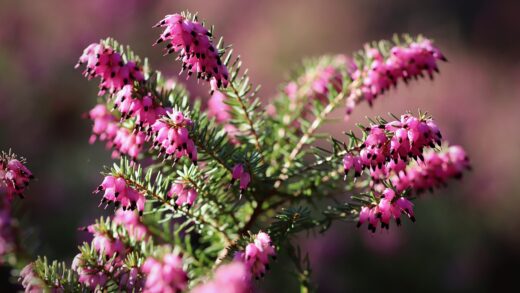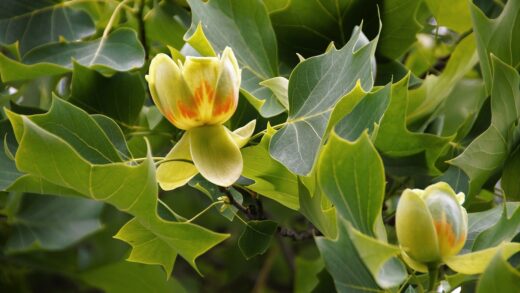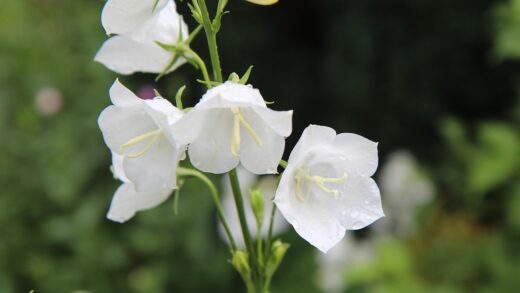The American tulip tree, known scientifically as Liriodendron tulipifera, is a truly majestic deciduous tree that, with its unique, tulip-like flowers and characteristically shaped leaves, rightly becomes the pride of any garden. Although the species is fundamentally hardy in our climate, a successful and damage-free overwintering, especially for young specimens of a few years, is by no means a given. Careful and professional preparation for winter ensures that the tree not only survives but also begins the new growing season strong and healthy, thereby laying the foundation for abundant flowering and impressive foliage in the next season. Understanding and correctly applying this process is the key to cultivating a long-term healthy and spectacular tulip tree.
Successful overwintering does not begin with the first frosts but with a conscious preparation process that starts as early as late summer and autumn. During this period, we must bring the tree into a state where its internal processes are attuned for winter and the plant tissues are prepared to withstand the stress caused by the cold. Modifying nutrition and correct watering practices contribute to the tree facing winter not with soft, frost-sensitive shoots, but with matured, hardened-off branches. This proactive care is far more effective than the subsequent treatment of frost damage that has already occurred, which is often only symptomatic and less successful.
It is important to distinguish between the overwintering needs of freshly planted, young saplings and those of older, stronger, well-established trees. While the root system and trunk of young specimens are more vulnerable and require active protection from frost, the scorching winter sun, and rodents, older trees are much more resilient due to their thick bark and extensive root system. In their case, overwintering is more about a preventive assessment of their condition and mitigating damage from extreme weather events (such as heavy snow loads). Choosing care appropriate for the tree’s age and condition is essential for success.
The goal of overwintering procedures is, therefore, to create a kind of protective shield around the plant, which protects both the underground and above-ground parts. Thermal insulation of the root zone with mulching, protection of the trunk from frost cracks and sunscald, as well as the prevention of damage from wildlife, are all elements that together ensure the tree’s integrity. In the following chapters, we will present these steps in detail so that everyone can confidently apply professional techniques in their own garden, guaranteeing a healthy spring awakening for their tulip tree.
Autumn Preparation: Laying the Foundation for Hardiness
One of the most important elements in the autumn preparation of the tulip tree is ensuring an adequate water supply. At the end of the growing season, especially during dry, rainless autumns, it is essential to water the tree thoroughly and deeply before the ground freezes. This generous dose of water fills the plant’s tissues and the soil in the root zone with moisture, preventing so-called winter drought or physiological desiccation. The winter sun and wind evaporate water from the tree’s trunk and branches, which cannot be replenished from the frozen ground, leading to serious damage. A thorough autumn watering thus creates a kind of water reserve for the plant for the critical winter months.
More articles on this topic
Consciously modifying nutrition is also crucial for preparation. From the middle of summer, and at the latest from the beginning of August, the use of nitrogen-high fertilizers should be avoided, as they stimulate lush growth of new shoots. These fresh, soft tissues cannot mature and harden off properly before the arrival of winter, making them extremely sensitive to frost and easily turning black and getting damaged in the first serious frosts. Instead, in late summer and early autumn, potassium-rich preparations should be preferred, as potassium promotes the strengthening of cell walls and the maturation of woody parts, thereby significantly increasing the plant’s frost hardiness.
The issue of autumn leaf cleanup also deserves consideration in the case of the tulip tree. Although fallen leaves can function as a natural soil cover and nutrient source, it is advisable to remove them from the immediate vicinity of the tree trunk. a continuous, moist layer of leaves offers an ideal hiding and overwintering place for the spores of various fungal diseases and for pests such as slugs or rodents. By keeping the area around the trunk clean, we reduce the risk of infection and prevent rodents, hidden under the leaves, from damaging the tree’s bark unnoticed.
The last step before the onset of winter is a thorough visual inspection of the tree’s condition. Walk around the tree and look for damaged, sickly-looking, or dead branches, as well as any signs of pest infestation. Such problematic parts should be removed after leaf fall but before the hard frosts, using clean and sharp pruning shears or a saw. Treating the wounds is easier at this time, and we can prevent diseases or pests from overwintering on the tree and attacking it in the spring when it is weakened. With this forward-thinking care, we send a much healthier and more resilient plant into its winter dormancy.
Protecting Young Trees in the Critical First Years
For young, freshly planted tulip trees, the most important winter task is protecting the root zone from hard frosts. This is most easily achieved by mulching the soil, i.e., creating an insulating layer between the soil surface and the freezing air. After the leaves have fallen, as the first frosts approach, spread a layer of organic mulch about 10-15 centimeters (4-6 inches) thick, such as bark, wood chips, or even straw, around the base of the tree. The mulch layer should not be in direct contact with the tree trunk; leave a small, a-hand’s-width-wide free area to prevent bark rot.
More articles on this topic
The thin bark of young trees is particularly vulnerable to two specific phenomena of winter weather: frost cracks and sunscald. Sunscald occurs when the low winter sun heats the typically southwestern side of the tree trunk, after which the nightly frost causes the bark cells to die and the tissues to crack. The most effective method of prevention is trunk protection, which can be achieved with a white, light-reflecting tree paint or by wrapping with special, flexible trunk protector nets or jute strips. This protection prevents excessive heating of the bark and abrupt temperature fluctuations.
During the winter months, wildlife and rodents searching for food pose a serious threat to young trees. Rabbits and voles love to gnaw on the tender bark at the base of the tree, which can even lead to the tree’s death if the gnawing encircles the entire trunk. Deer, on the other hand, may browse on young branch tips and buds. Effective protection against this damage is provided by plastic trunk protector spirals or cylinders made of dense wire mesh, which are placed around the trunk. It is important that the protective device is tall enough to also protect the parts that protrude above the snow.
Finally, based on the experiences of the first few winters, it is worthwhile to evaluate the tree’s planting location. If you notice that the plant regularly suffers from frost damage, it is possible that it was planted in a so-called “frost pocket,” where cold air stagnates and the nightly cooling is more intense. Similarly, in a location highly exposed to wind, the drying effect of winter is amplified. Although it is not easy to move an already planted tree, the experience can help in future plant selection or encourage the creation of a windbreak to protect the tree.
Winter Care for Older, Established Tulip Trees
Older American tulip trees, which have been in their place for at least five to six years and are well-rooted, become extremely resistant to winter weather. Their extensive and deep root system can already absorb some moisture from the deeper, unfrozen soil layers, and their thick, furrowed bark provides effective natural insulation for the trunk. As a result, for mature specimens, the list of winter tasks is significantly shortened, and care is mainly limited to prevention and observation. Active protective measures applied to young trees, such as trunk wrapping or mulching the root zone, are generally no longer necessary.
The question of winter watering for older trees rarely arises, but it cannot be completely ruled out. During an unusually mild and extremely dry, rainless winter, when the top layer of soil remains unfrozen for a longer period, a thorough watering can be beneficial for the tree. This helps to prevent the risk of winter drought and ensures that the tree begins the spring sap flow with adequate hydration. However, such an intervention is only necessary in the case of truly extreme, weeks-long drought; under normal winter precipitation conditions, nature takes care of the tree’s water supply.
The role of the snow cover in the tree’s winter life is twofold. A thick, persistent snow cover acts as an excellent natural insulator, protecting the soil and the roots within it from deep freezing, which is particularly beneficial. At the same time, a large amount of wet, sticky snow can place a considerable load on the tree’s branches, especially on the older, more horizontally growing ones. After a heavy snowfall, it is advisable to gently brush off the excess snow load from the branches with a long-handled broom or tool, to prevent branch breakage and damage to the crown’s structure.
The most important element of overwintering older tulip trees is regular, but not intrusive, observation. After a winter storm or strong wind, it is wise to walk around the tree and assess any potential damage, such as broken branches. Timely detection of such injuries and the professional removal of the broken branches prevent further cracking and the entry of pathogens through the wound surfaces. This passive, attentive care ensures that the tree weathers the winter healthy and structurally sound, ready for its spring renewal.
Potential Winter Damage and Its Prevention
One of the characteristic problems of the winter period, mainly affecting young trees with thin bark, is the frost crack. This phenomenon occurs when the bark, warmed by the daytime sun, contracts abruptly during the rapid nightly cooling, which can cause deep longitudinal cracks on the tree trunk. Although the tree begins to heal these wounds in the spring, they can become a gateway for various wood-decaying fungi and other pathogens. The most effective method of prevention is the aforementioned trunk protection, i.e., whitewashing the trunk or covering it with special materials that mitigate temperature fluctuations.
Sunscald is another form of damage, closely related to frost cracks, which is also a consequence of winter temperature fluctuations. It primarily affects the southwestern side of the trunk, where the winter sun hits the bark most strongly. The warming phloem tissues under the bark (the cambium) can be activated prematurely and then die during the nightly frost, leading to bark necrosis and peeling. Sunlight reflected from the snow can further exacerbate this effect. The prevention here also consists of shading the trunk or providing it with a reflective coating during the critical first few years.
Winter desiccation is an insidious phenomenon that affects not only deciduous, but also evergreen plants. On cold, but sunny and windy winter days, the plant constantly evaporates water through its trunk and branches, while it cannot absorb moisture from the frozen ground. As a result, the tree can literally dry out, which manifests in the spring by the failure of the buds to open and the dying of branches. The basis of prevention is the thorough autumn watering, which ensures that the tree enters the winter with maximum water reserves, as well as mulching the root zone, which somewhat mitigates the depth of soil freezing.
Preventing animal damage is a complex task that requires knowledge of the local wildlife. Voles and mice, under the snow cover, can cause fatal damage by girdling the base of the tree, while rabbits can also reach the higher parts of the trunk. Deer and roe deer prefer young shoots and buds. The most effective method of defense is the use of physical barriers, i.e., the aforementioned trunk protector nets and guards. In case of severe wildlife damage, it may be necessary to fence the entire tree or use repellents, although their effectiveness may vary.
Spring Tasks: Waking the Tree from Its Winter Slumber
As the grip of winter loosens and spring arrives, it is time to remove the winter protective gear. The jute tape, reed mat, or plastic spiral protecting the trunk should be removed when the danger of hard night frosts has passed, but before the persistently warm weather sets in. It is ideal to choose a cloudy day for this operation, so that the sensitive bark, which has been covered for months, is not suddenly exposed to strong sunlight, but gradually gets used to the new conditions. A protective cover left on for too long can trap moisture and encourage fungal diseases and the settlement of insects.
Spring is the time for assessing winter damage and for pruning. Before the buds break, at the beginning of the sap flow, thoroughly inspect the tree’s crown. Look for dead, frozen, storm-broken, or damaged branches and remove them with sharp, disinfected pruning shears or a saw. The cut should always be made back to healthy wood, just above a side branch or bud, creating a slanted cut surface. In this way, you not only improve the aesthetic appearance of the tree, but also prevent the spread of diseases and stimulate the growth of new, strong shoots.
After the period of winter dormancy, the tree needs energy for the spring growth spurt. Once the soil has completely thawed and is easy to work, it is recommended to apply a balanced, slow-release, complex fertilizer to the area under the tree’s crown projection. This nutrient supply replenishes the reserves depleted during the winter and provides the necessary macro- and micronutrients for leafing out, shoot growth, and later flowering. Work the fertilizer shallowly into the soil and then water thoroughly so that the nutrients reach the root zone.
Finally, spring tasks also include the maintenance of the mulch. It is advisable to loosen the winter mulch layer a bit and pull it away from the tree trunk, to allow the spring sun to warm the soil better, thereby stimulating root activity. After a few weeks, when the soil has warmed up enough, the old mulch can be supplemented with a fresh layer. This will help to retain soil moisture during the summer season, prevent the growth of weeds, and improve the soil structure as the organic materials slowly decompose.


















